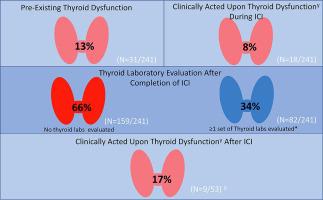Lung Cancer ( IF 5.3 ) Pub Date : 2021-08-30 , DOI: 10.1016/j.lungcan.2021.08.009 Nanruoyi Zhou 1 , Maria A Velez 1 , Benjamin Bachrach 1 , Jaklin Gukasyan 1 , Charlene M Fares 1 , Amy L Cummings 1 , Jackson P Lind-Lebuffe 1 , Wisdom O Akingbemi 1 , Debory Y Li 1 , Paige M Brodrick 1 , Nawal M Yessuf 1 , Sarah Rettinger 2 , Tristan Grogan 1 , Philippe Rochigneux 3 , Jonathan W Goldman 1 , Edward B Garon 1 , Aaron Lisberg 1

|
Introduction
Thyroid dysfunction is the most frequent endocrine immune related adverse event (irAE) in non-small cell lung cancer (NSCLC), typically arising 3–6 months into immune checkpoint inhibitor (ICI) therapy, but arising after ICI cessation, in some cases. Due to limited post-treatment adverse event reporting requirements on ICI trials, the incidence of ICI-induced thyroid dysfunction arising after therapy is unclear. We investigated ICI-induced thyroid dysfunction in a cohort of 294 NSCLC patients, with a specific focus on the post-treatment setting.
Methods
Retrospective analysis of ICI-induced thyroid dysfunction (clinically acted upon or laboratory only) was performed in 294 UCLA NSCLC patients treated 2012–2018. Clinically acted upon thyroid dysfunction was defined as thyroid diagnosis documentation and/or thyroid medication administration. Laboratory only dysfunction was defined as abnormal thyroid labs in the absence of clinical action. Timing of thyroid dysfunction relative to ICI treatment and thyroid monitoring patterns were also assessed.
Results
82% (241/294) of ICI treated NSCLC patients had thyroid labs during treatment. Of these 241 patients, 13% (31/241) had clinically acted upon thyroid dysfunction prior to, 8% (18/241) during, and 4% (9/241) after ICI. Most patients, 66% (159/241), did not have thyroid labs after ICI, but in the 53 patients with labs and no prior clinical dysfunction, 17% (9/53) developed clinical dysfunction after ICI. In these 9 patients, median time from ICI initiation to dysfunction was 253 days. Two patients with post-treatment laboratory only dysfunction were observed.
Conclusions
ICI-induced thyroid dysfunction arising post-treatment appears more common than previously appreciated, warranting additional evaluation.
中文翻译:

免疫检查点抑制剂诱发的甲状腺功能障碍是 NSCLC 治疗后的常见事件
介绍
甲状腺功能障碍是非小细胞肺癌 (NSCLC) 中最常见的内分泌免疫相关不良事件 (irAE),通常在免疫检查点抑制剂 (ICI) 治疗后 3-6 个月出现,但在某些情况下会在 ICI 停止后出现。由于 ICI 试验对治疗后不良事件报告的要求有限,治疗后 ICI 诱发的甲状腺功能障碍的发生率尚不清楚。我们在 294 名 NSCLC 患者的队列中调查了 ICI 引起的甲状腺功能障碍,特别关注治疗后环境。
方法
在 2012-2018 年接受治疗的 294 名 UCLA NSCLC 患者中对 ICI 诱发的甲状腺功能障碍(临床上或仅实验室)进行了回顾性分析。对甲状腺功能障碍的临床作用被定义为甲状腺诊断文件和/或甲状腺药物管理。仅实验室功能障碍被定义为在没有临床行动的情况下的异常甲状腺实验室。还评估了与 ICI 治疗和甲状腺监测模式相关的甲状腺功能障碍的时间。
结果
82% (241/294) 接受 ICI 治疗的 NSCLC 患者在治疗期间进行了甲状腺实验室检查。在这 241 名患者中,13% (31/241) 在 ICI 之前、8% (18/241) 和 4% (9/241) 在 ICI 之后临床上对甲状腺功能障碍起作用。大多数患者(66% (159/241))在 ICI 后没有进行甲状腺实验室检查,但在 53 名进行实验室检查且既往无临床功能障碍的患者中,17% (9/53) 在 ICI 后出现临床功能障碍。在这 9 名患者中,从 ICI 开始到功能障碍的中位时间为 253 天。观察到两名治疗后实验室仅功能障碍的患者。
结论
治疗后出现的 ICI 诱发的甲状腺功能障碍似乎比以前认为的更常见,需要额外评估。



























 京公网安备 11010802027423号
京公网安备 11010802027423号